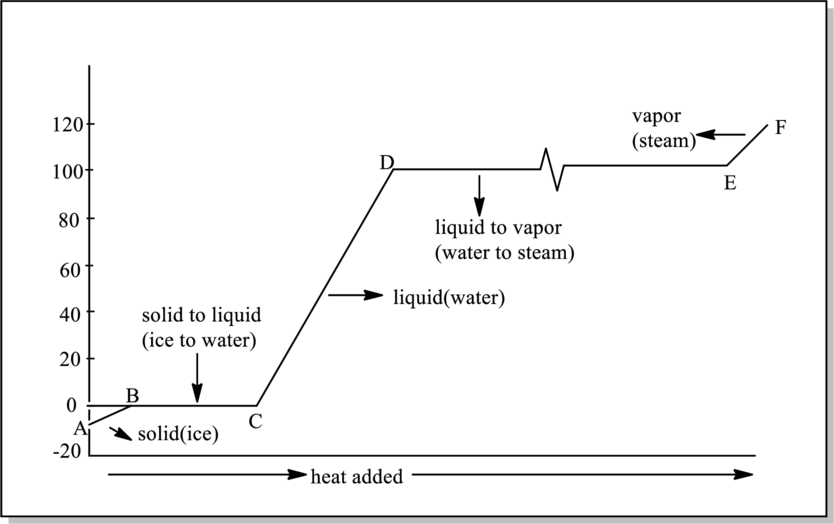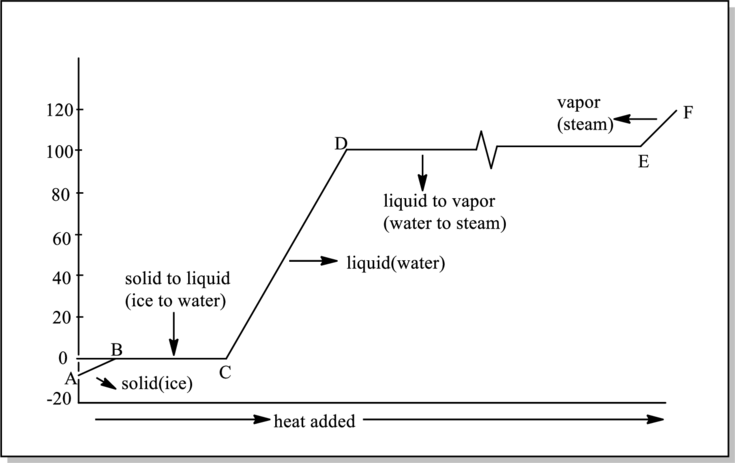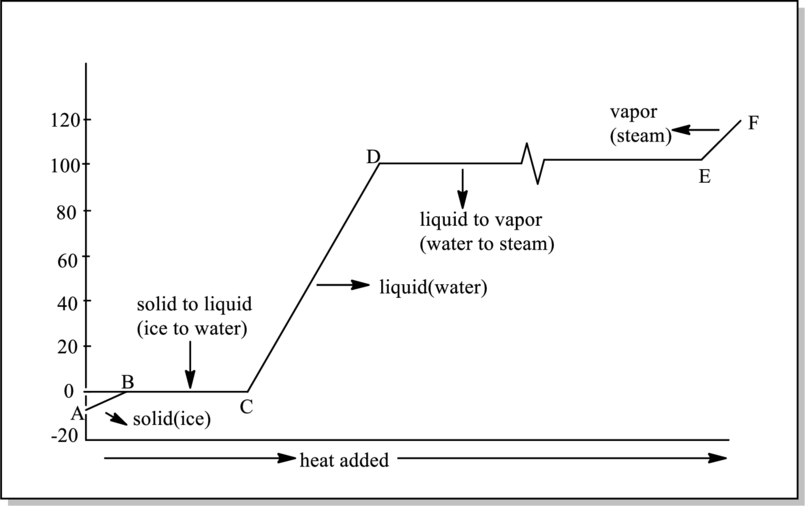
(a)
Interpretation:
Reason for line BC to be horizontal in below graph has to be explained. Also, reason for that happens in BC interval has to be determined.

Concept Introduction:
Heat of fusion is amount of heat required to convert solid to liquid. Every substance has different heat of fusion. Heat of fusion for ice is
Heat of vaporization is quantity of heat absorbed on vaporization of a liquid. Every substance has different heat of vaporization. It is represented as
(b)
Interpretation:
Phases that are present in interval BC in below graph have to be determined.

Concept Introduction:
Refer to part (a).
(c)
Interpretation:
Reason for line DE has to be given.

Concept Introduction:
Refer to part (a).
Want to see the full answer?
Check out a sample textbook solution
Chapter 13 Solutions
FOUNDATIONS OF COLLEGE CHEM +KNEWTONALTA
- pls helparrow_forwardState the reason why compound A (m.p. 99-100°C) is heated under vacuum.1. So that the sample heating temperature is not too high when heated under vacuum.2. So that the temperature is higher than the melting point of compound A.3. So that cold water is not required in the sublimator.arrow_forwardTo find the theoretical % yield of a given reaction:1. actual amount obtained once crystallized2. (actual amount obtained / theoretical amount) x 1003. maximum amount of product that can be obtained / amount of initial reactantarrow_forward
- The reason activated carbon decolorizes and purifies a product is:1. It helps dissolve the product and then recrystallize it.2. It reacts with impurities in the product and removes them.3. It retains impurities by adsorption, purifying the product.arrow_forwardThe principle of a rotary evaporator is the same as that of:1. vacuum distillation2. reflux3. fractional distillationarrow_forwardAnhydrous MgSO4 is used to:1. Form a salt with the compound dissolved in the solution2. Remove water from a solution3. Neutralize a solutionarrow_forward
- Distillation under reduced pressure or vacuum consists of:1. Achieving distillation under anhydrous conditions.2. Causing a decrease in the distillation rate.3. Decreasing the pressure to lower the boiling point of the compound to be distilled.arrow_forwardAt the end of the silica gel production process, color changes occur during drying. Explain these color changes.arrow_forwardIf CoCl2/H2O is dissolved in a mixture of H2O and concentrated HCl in a test tube, the tube is gently heated over a flame to approximately 80°C and then cooled externally. Explain the color changes that occur.arrow_forward
- When producing silica gel, color changes occur at the end of the drying process. Explain these color changes.arrow_forwardDesign experiments in UV-Vis to figure the optimal mole ratio of copper (1:1, 2:1, 3:1 and etc)versus ethambutol using all necessary chemicals including dihydrochloride and copper nitrate hemipentahydrate and sodium hydroxide. Show how UV-Vis absorbance and maximum wavelength would change in responsearrow_forwardCorrect each molecule in the drawing area below so that it has the condensed structure it would have if it were dissolv a 0.1 M aqueous solution of HCI. If there are no changes to be made, check the No changes box under the drawing area. No changes. HO—CH,—C—CH,—OH X 5 2 2 2 HO–CH,—CH,—C—CH,—OH Explanation Check Center Accessi ©2025 on 5 Carrow_forward
 Introductory Chemistry: A FoundationChemistryISBN:9781337399425Author:Steven S. Zumdahl, Donald J. DeCostePublisher:Cengage Learning
Introductory Chemistry: A FoundationChemistryISBN:9781337399425Author:Steven S. Zumdahl, Donald J. DeCostePublisher:Cengage Learning Chemistry: The Molecular ScienceChemistryISBN:9781285199047Author:John W. Moore, Conrad L. StanitskiPublisher:Cengage Learning
Chemistry: The Molecular ScienceChemistryISBN:9781285199047Author:John W. Moore, Conrad L. StanitskiPublisher:Cengage Learning Chemistry: Principles and ReactionsChemistryISBN:9781305079373Author:William L. Masterton, Cecile N. HurleyPublisher:Cengage Learning
Chemistry: Principles and ReactionsChemistryISBN:9781305079373Author:William L. Masterton, Cecile N. HurleyPublisher:Cengage Learning ChemistryChemistryISBN:9781305957404Author:Steven S. Zumdahl, Susan A. Zumdahl, Donald J. DeCostePublisher:Cengage Learning
ChemistryChemistryISBN:9781305957404Author:Steven S. Zumdahl, Susan A. Zumdahl, Donald J. DeCostePublisher:Cengage Learning Chemistry: An Atoms First ApproachChemistryISBN:9781305079243Author:Steven S. Zumdahl, Susan A. ZumdahlPublisher:Cengage Learning
Chemistry: An Atoms First ApproachChemistryISBN:9781305079243Author:Steven S. Zumdahl, Susan A. ZumdahlPublisher:Cengage Learning





